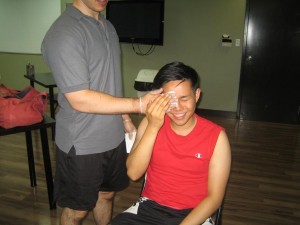How eye injuries occur
Injury to the eyes can occur in many different settings, but will always be the result of unwanted trauma that could possibly be avoided. More often that not injury sustained to the eye, or eyes, results from accidental or purposeful impact, such as:

1) Fighting
The type of injury endured during a scuffle is considered high impact and can produce minor to long-lasting damage. In the case of professional fighters and boxers eye damage is unfortunately quite common.
2) Abrasions and scratches
This is normally classified as accidental damage. It could be anything from a bit of dust that becomes lodged in the eyelid to a low-hanging branch that strikes an unwary individual without warning. Even scratching at your eyes can cause this type of damage.
3) Penetrating injuries
This type of high-impact injury is almost always accidental as it can result from particles that have been flung into the air during construction or other hazardous activities.
4) Chemical exposure
Many cleaning products and other such abrasive chemicals have warnings and advisory labels on what to do if they should come in contact with your eyes. This is typically accidental but can cause long-lasting damage if not treated immediately.
5) Radiation
While not as noticeable at first, radiation poisoning doesn’t just affect the eyes most times, but can be very painful, not to mention lethal if steps are not taken to treat the affected regions.
How to treat injuries to the eyes
Many common and non-threatening injuries to the eyes can be taken care of at home with painkillers and flushing them out if necessary. If the pain persists or grows worse though it is recommended to consult a doctor to see how serious the condition is. If you’ve sustained an eye injury that is non-threatening there are a few tips that are useful when attempting to treat the injury at home.
1) Don’t rub your eyes.
This will only aggravate the eyes and make whatever is wrong worse.
2) Flush your eyes as needed.
This is recommended if you have loose particles in your eyes or have been exposed to abrasive and/or harmful chemicals. If you have injured only one eye, tilt your head before you begin cup water into the injured eye, taking care to pour the water over the bridge of your nose so it will maximize how much reaches your eye.
If both eyes are injured, use this same process, but instead tilt your head back and pour water across the bridge of your nose so both eyes receive water. Other methods include standing in the shower and allowing the stream to hit just above your eyes. If you are working outside when the injury occurs a hose can be just as effective.
In the case of chemical exposure, it is recommended to see a doctor even after flushing the eyes, so as to insure that there is no lasting damage or remaining particles.
